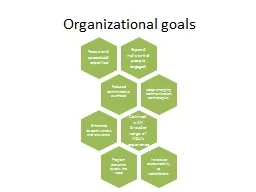

Agriculture Goals including home gardeners Greening Michigan Institute Goals Children amp Youth Goals Target audience is children and youth ages Birth through 19 and the adults that support them ID: 480432
Download Presentation The PPT/PDF document "Organizational goals" is the property of its rightful owner. Permission is granted to download and print the materials on this web site for personal, non-commercial use only, and to display it on your personal computer provided you do not modify the materials and that you retain all copyright notices contained in the materials. By downloading content from our website, you accept the terms of this agreement.
Slide1
Organizational goalsSlide2
Agriculture Goals (including home gardeners)Slide3
Greening Michigan Institute GoalsSlide4
Children & Youth Goals
(Target audience is children and youth ages Birth through 19 and the adults that support them.)Slide5
Health and Nutrition Institute Goals
Increased adoption of safe food handling practices in individuals, families and businesses
Increased adoption of USDA food preservation guidelines in food preservation practices
Reduce the risk for foodborne illness.
Increased adoption of preventative practices related to the onset of diabetes.
Reduce the incidence of risk factors for diabetes
Increase management of diabetes and other chronic diseases
Increase in adoption of behaviors related to healthy relationships , anti-bullying, and the prevention of interpersonal violence.
Reduce the incidence of risk for interpersonal violence, such as bullying and worksite violence.
Increased adoption of healthy food practices
Increased participation in regular physical activity
Increased adoption of food resource management practices
Reduce the incidence of risk factors for obesity and other nutrition-related health problems
Increased adoption of practices to better manage diabetes and other chronic diseases.